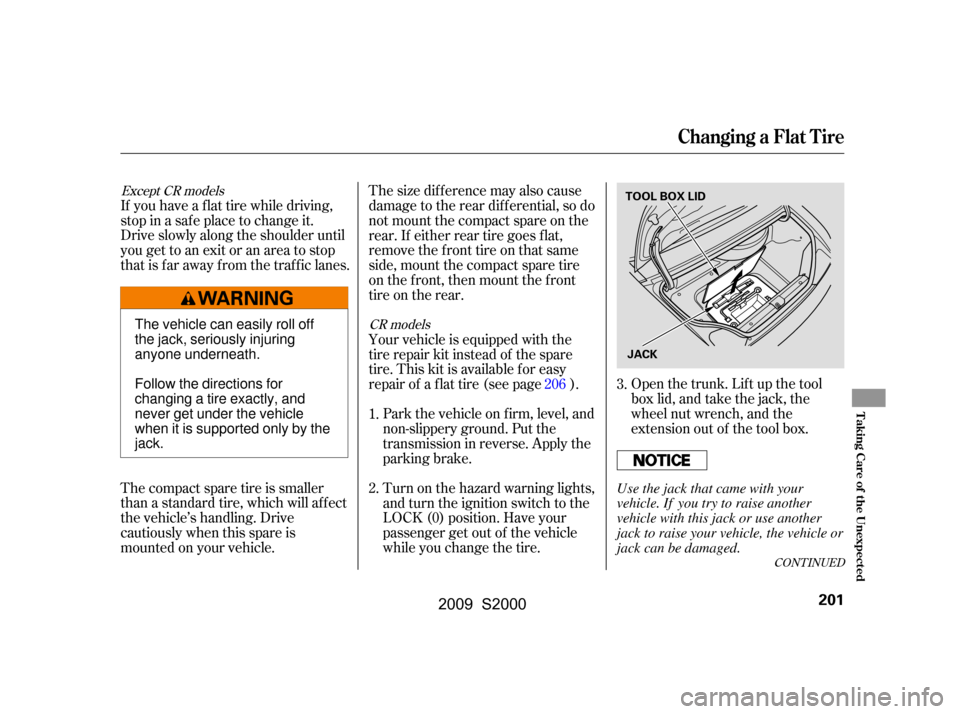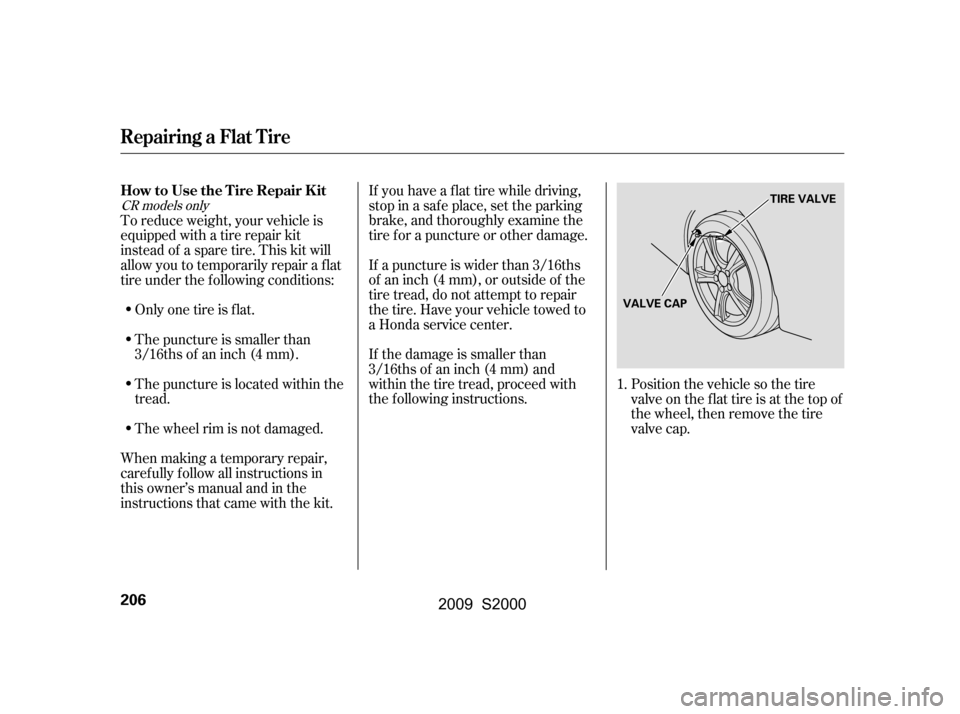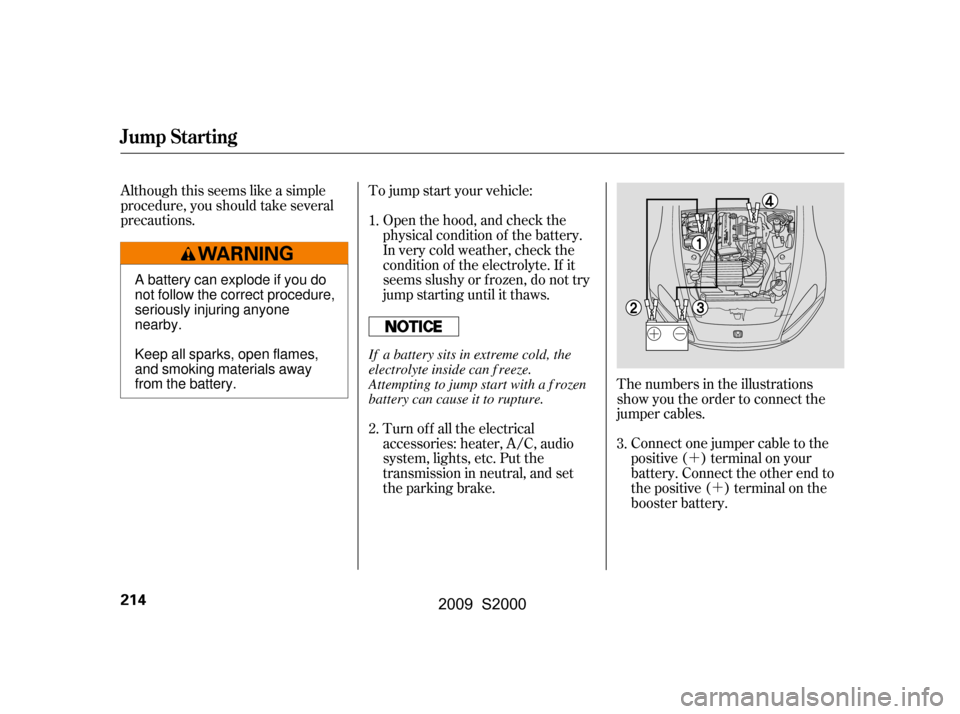Page 198 of 268
Tires
Maint enance
195
Using the wrong chains, or not
properly installing chains, can
damage the brake lines and
cause a crash in which you can
be seriously injured or killed.
Follow all instructions in this
owner’s manual regarding the
selection and use of tire chains.
Traction devices that are the wrong
size or improperly installed can
damage your vehicle’s brake lines,
suspension, body, and wheels. Stop
driving if they are hitting any part of
the vehicle.
2009 S2000
Page 201 of 268

If you need to park your vehicle f or
an extended period (more than 1
month), there are several things you
should do to prepare it f or storage.
Proper preparation helps prevent
deterioration and makes it easier to
get your vehicle back on the road. If
possible, store your vehicle indoors.Fill the f uel tank. Block the rear wheels.
If the vehicle is to be stored f or a
longer period, it should be
supported on jackstands so the
tires are of f the ground.
Leave one window open slightly (if
the vehicle is being stored
indoors).
Disconnect the battery.Cover the vehicle with a
‘‘breathable’’ cover, one made
f rom a porous material such as
cotton. Non-porous materials, such
as plastic sheeting, trap moisture,
which can damage the paint.
Support the f ront wiper blade
arms with a f olded towel or rag so
they do not touch the windshield.
To minimize sticking, apply a
silicone spray lubricant to all door
and trunk seals. Also, apply a
vehiclebodywaxtothepainted
surfaces that mate with the door
and trunk seals. If possible, periodically run the
engine until it reaches f ull
operating temperature (the
cooling f an cycles on and of f
twice). Pref erably, do this once a
month.
Wash and dry the exterior
completely.
Cleantheinterior.Makesurethe
carpeting, floor mats, etc., are
completely dry.
Raise the convertible top cover.
Leave the parking brake off. Put
the transmission in reverse.
Vehicle Storage
198
2009 S2000
Page 202 of 268

This section covers the more
common problems that motorists
experience with their vehicles. It
gives you inf ormation about how to
safely evaluate the problem and what
to do to correct it. If the problem has
stranded you on the side of the road,
you may be able to get going again.
If not, you will also f ind instructions
on getting your vehicle towed.......................
Compact Spare Tire .200
....................
Changing a Flat Tire .201
....................
Repairing a Flat Tire .206
.............
If the Engine Won’t Start .212
................................
Jump Starting .214
..............
If the Engine Overheats .215
.........
Low Oil Pressure Indicator .218
..........
Charging System Indicator .218
.......
Malf unction Indicator Lamp .219
...............
Brake System Indicator .220
.......
Closing the Convertible Top .221
..............................................
Fuses .222
..........
Checking and Replacing .223
..............................
Fuse Locations .226
......................
Emergency Towing .228
..........
If Your Vehicle Gets Stuck .228
Taking Care of the Unexpected
T aking Care of t he Unexpect ed
199
2009 S2000
Page 204 of 268

Open the trunk. Lift up the tool
box lid, and take the jack, the
wheel nut wrench, and the
extension out of the tool box.
Thecompactsparetireissmaller
than a standard tire, which will affect
the vehicle’s handling. Drive
cautiously when this spare is
mounted on your vehicle.
If you have a f lat tire while driving,
stop in a saf e place to change it.
Drive slowly along the shoulder until
you get to an exit or an area to stop
that is far away from the traffic lanes.
Turn on the hazard warning lights,
and turn the ignition switch to the
LOCK (0) position. Have your
passenger get out of the vehicle
while you change the tire.
Park the vehicle on f irm, level, and
non-slippery ground. Put the
transmission in reverse. Apply the
parking brake.
Thesizedifferencemayalsocause
damage to the rear dif f erential, so do
not mount the compact spare on the
rear. If either rear tire goes f lat,
remove the f ront tire on that same
side, mount the compact spare tire
on the f ront, then mount the f ront
tire on the rear.
Your vehicle is equipped with the
tire repair kit instead of the spare
tire. This kit is available f or easy
repair of a f lat tire (see page ). 3.
1.
2.
206
CONT INUED
Except CR models
CR models
Changing a Flat Tire
T aking Care of t he Unexpect ed
201
TOOL BOX LID
JACK
The vehicle can easily roll off
the jack, seriously injuring
anyone underneath.
Follow the directions for
changing a tire exactly, and
never get under the vehicle
when it is supported only by the
jack. Use the jack that came with your
vehicle. If you try to raise another
vehicle with this jack or use another
jack to raise your vehicle, the vehicle or
jack can be damaged.
2009 S2000
Page 206 of 268
Use the extension and the wheel
nut wrench as shown to raise the
vehicle until the f lat tire is of f the
ground.Bef ore mounting the spare tire,
wipeanydirtoff themounting
surface of the wheel and hub with
a clean cloth. Wipe the hub
carefully;itmaybehotfrom
driving.
Remove the wheel nuts, then
removetheflattire.Handlethe
wheel nuts caref ully; they may be
hot from driving. Place the flat tire
on the ground with the outside
surface facing up.
8.
9.10.
CONT INUED
Changing a Flat Tire
T aking Care of t he Unexpect ed
203
BRAKE HUB
EXTENSION
2009 S2000
Page 209 of 268

If you have a f lat tire while driving,
stop in a saf e place, set the parking
brake, and thoroughly examine the
tire f or a puncture or other damage.
If a puncture is wider than 3/16ths
of an inch (4 mm), or outside of the
tire tread, do not attempt to repair
the tire. Have your vehicle towed to
a Honda service center.
If the damage is smaller than
3/16ths of an inch (4 mm) and
within the tire tread, proceed with
the f ollowing instructions.
When making a temporary repair,
caref ully f ollow all instructions in
this owner’s manual and in the
instructions that came with the kit. The wheel rim is not damaged.
The puncture is located within the
tread.
The puncture is smaller than
3/16ths of an inch (4 mm).
Only one tire is f lat.
To reduce weight, your vehicle is
equipped with a tire repair kit
instead of a spare tire. This kit will
allow you to temporarily repair a f lat
tire under the f ollowing conditions:
Position the vehicle so the tire
valve on the flat tire is at the top of
the wheel, then remove the tire
valve cap.
1.
CR models only
Repairing a Flat T ire
HowtoUsetheTireRepairKit
206
TIRE VALVE
VALVE CAP
2009 S2000
Page 217 of 268

�´�´
Although this seems like a simple
procedure, you should take several
precautions. Open the hood, and check the
physical condition of the battery.
In very cold weather, check the
condition of the electrolyte. If it
seems slushy or f rozen, do not try
jump starting until it thaws.
To jump start your vehicle:
Connect one jumper cable to the
positive ( ) terminal on your
battery. Connect the other end to
the positive ( ) terminal on the
booster battery.
Turn of f all the electrical
accessories: heater, A/C, audio
system, lights, etc. Put the
transmission in neutral, and set
the parking brake. The numbers in the illustrations
show you the order to connect the
jumper cables.
3.
1.
2.
Jump Starting
214
A battery can explode if you do
not follow the correct procedure,
seriously injuring anyone
nearby.
Keep all sparks, open flames,
and smoking materials away
from the battery.
If a battery sits in extreme cold, the
electrolyte inside can f reeze.
Attempting to jump start with a f rozen
battery can cause it to rupture.
2009 S2000
Page 219 of 268

Look f or any obvious coolant leaks,
such as a split radiator hose.
Everything is still extremely hot,
so use caution. If you f ind a leak, it
must be repaired bef ore you
continue driving (seeon page ).
If the temperature gauge stays at
the red mark, turn of f the engine.
If you do not see steam or spray,
leave the engine running and
watch the temperature gauge. If
the high heat is due to overloading,
the engine should start to cool
down almost immediately. If it
does, wait until the temperature
gauge comes down to the midpoint,
then continue driving. If you see steam and/or spray
coming f rom under the hood, turn
of f the engine. Wait until you see
no more signs of steam or spray,
then open the hood. Saf ely pull to the side of the road.
Put the transmission in neutral,
and set the parking brake. Turn
of f the all accessories, and turn on
the hazard warning lights. If you don’t f ind an obvious leak,
check the coolant level in the
radiator reserve tank. Add coolant
if the level is below the MIN mark
(seeon
page ).
2. 1.
3. 4.
5.
6.
173 228
Emergency
Towing
A dding Engine Coolant
If theEngineOverheats
216
Steam and spray from an
overheated engine can
seriously scald you.
Do not open the hood if steam
is coming out.
2009 S2000